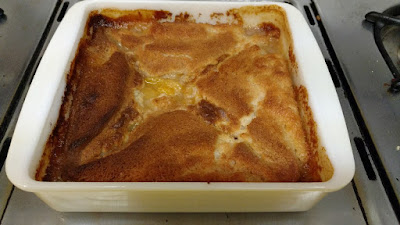
Recipe: Summer peaches, nectarines featured in this version of Blue Ribbon Cobbler

(Photos: Debbie Arrington) |
One of the great pleasures of midsummer is a rich and satisfying fruit dessert that makes the most of a sweet-tart bounty.
My favorite is this cobbler: easier than pie and flexible to what’s ripe.
I discovered this recipe 35 years ago when I first started writing about food. “Blue Ribbon Peach Cobbler,” which according to accompanying recipe notes won top prize at an unnamed state fair, was part of Ronald Johnson’s wonderful “The American Table: A Festive Sampler of Regional Cooking at its Savory Best.” Johnson encouraged readers to substitute other fruit or combinations for the peaches, which I have done often.
In honor of closing day of our State Fair, this Blue Ribbon Cobbler will win smiles at summer gatherings. (Just use the correct size pan.)
The example here uses yellow peaches and nectarines, peeled and sliced. Strawberry-rhubarb, peach-blueberry, apple-rhubarb, mixed berries; all these combos work well, as do straight peaches or other fruit.
The recipe itself looks out of whack with way more sugar than flour, plus lots of butter. That’s what makes it delicious. The batter bubbles when it’s spooned over the melted butter, and the fruit is dropped on top, not layered underneath. As the cobbler cooks, the fruit sinks down into the batter. The top and sides develop a rich, brown crunchy crust, wrapped around sweet-tart syrupy filling.
All that sinking and rising needs some room. Use a DEEP baking dish (3 inches preferred), not a shallow pie pan. Place a cookie sheet under the baking dish to catch overflow, just in case.
Blue Ribbon Cobbler
Adapted from “The American Table,” by Ronald Johnson (Pocket Cookbook, 1984)

|
Comments
0 comments have been posted.Sacramento Digs Gardening to your inbox.
Sites We Like
Garden Checklist for week of April 14
It's still not warm enough to transplant tomatoes directly in the ground, but we’re getting there.
* April is the last chance to plant citrus trees such as dwarf orange, lemon and kumquat. These trees also look good in landscaping and provide fresh fruit in winter.
* Smell orange blossoms? Feed citrus trees with a low dose of balanced fertilizer (such as 10-10-10) during bloom to help set fruit. Keep an eye out for ants.
* Apply slow-release fertilizer to the lawn.
* Thoroughly clean debris from the bottom of outdoor ponds or fountains.
* Spring brings a flush of rapid growth, and that means your garden needs nutrients. Fertilize shrubs and trees with a slow-release fertilizer. Or mulch with a 1-inch layer of compost.
* Azaleas and camellias looking a little yellow? If leaves are turning yellow between the veins, give them a boost with chelated iron.
* Trim dead flowers but not leaves from spring-flowering bulbs such as daffodils and tulips. Those leaves gather energy to create next year's flowers. Also, give the bulbs a fertilizer boost after bloom.
* Pinch chrysanthemums back to 12 inches for fall flowers. Cut old stems to the ground.
* Mulch around plants to conserve moisture and control weeds.
* From seed, plant beans, beets, cantaloupes, carrots, corn, cucumbers, melons, radishes and squash.
* Plant onion sets.
* In the flower garden, plant seeds for asters, cosmos, celosia, marigolds, salvia, sunflowers and zinnias.
* Transplant petunias, zinnias, geraniums and other summer bloomers.
* Plant perennials and dahlia tubers for summer bloom.
* Mid to late April is about the last chance to plant summer bulbs, such as gladiolus and tuberous begonias.
* Transplant lettuce seedlings. Choose varieties that mature quickly such as loose leaf.